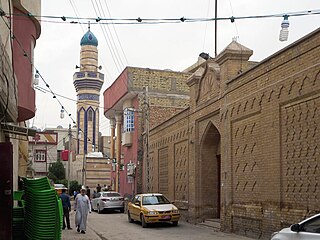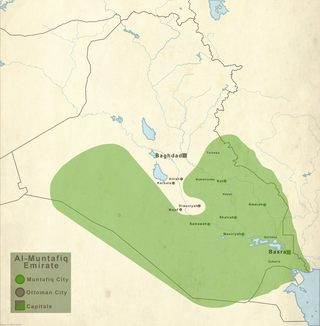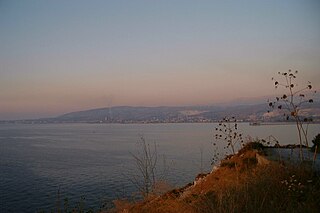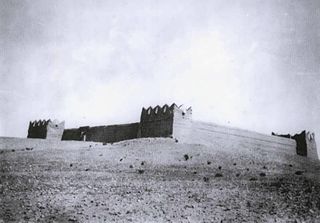Related Research Articles

Najd is the central region of Saudi Arabia, in which about a third of the country's modern population resides. It is the home of the House of Saud, from which it pursued unification with Hejaz since the time of the Emirate of Diriyah.

The Banu Hilal was a confederation of Arab tribes from the Najd region of the central Arabian Peninsula that emigrated to the Maghreb region of North Africa in the 11th century. Masters of the vast plateaux of the Najd, they enjoyed a somewhat infamous reputation, possibly owing to their relatively late conversion to Islam and accounts of their campaigns in the borderlands between Iraq and Syria. When the Fatimid Caliphate became the rulers of Egypt and the founders of Cairo in 969, they hastened to confine the unruly Bedouin in the south before sending them to Central North Africa and then to Morocco.

The Emirate of Diriyah, also known as the First Saudi State, was established in February 1727. In 1744, the emir of a Najdi town called Diriyah, Muhammad bin Saud, and the religious leader Muhammad ibn Abd al-Wahhab signed a pact to found a socio-religious reform movement to unify the many states of the Arabian Peninsula.

The Ikhwan, commonly known as Ikhwan man ata'a Allah, was a Wahhabi religious militia made up of traditionally nomadic tribesmen which formed a significant military force of the ruler Ibn Saud and played an important role in establishing him as ruler of most of the Arabian Peninsula in the Kingdom of Saudi Arabia.

Unaizah or officially The Governorate of Unaizah is a Saudi Arabian city in the Al Qassim Province. It lies south of the province capital Buraydah and north of Riyadh, the capital of the Kingdom of Saudi Arabia. It is the second largest city in Al-Qassim Province with a population of 184,600.

The Emirate of Nejd or Imamate of Nejd was the Second Saudi State, existing between 1824 and 1891 in Nejd, the regions of Riyadh and Ha'il of what is now Saudi Arabia. Saudi rule was restored to central and eastern Arabia after the Emirate of Diriyah, the First Saudi State, having previously been brought down by the Ottoman Empire's Egypt Eyalet in the Ottoman–Wahhabi War (1811–1818).
The Hadith of Najd is a hadith in Sahih Bukhari with several chains of narration about three geographical locations, one of which is prophesied to be the source of calamities. Sunni Muslims accept that the classification of the hadith as "sahih" (authentic).

Az Zubayr is a city in and the capital of Al-Zubair District, part of the Basra Governorate of Iraq. The city is just south of Basra. The name can also refer to the old Emirate of Zubair.
The Banu Bakr bin Wa'il, or simply Banu Bakr, today known as Bani Bakr an Arabian tribe belonging to the large Rabi'ah, a branch of Adnanite tribe. The tribe is reputed to have engaged in a 40-year war before Islam with its cousins from Taghlib, known as the War of Basous. The pre-Islamic poet, Tarafah was a Bakry.
Abd Allah ibn Abd al-Rahman ibn Jibrin, known simply as Ibn Jibrin, was a Saudi Islamic scholar who was a member of the Council of Senior Scholars and Permanent Committee for Islamic Research and Issuing Fatwas in Saudi Arabia.

Banu Yam is an Arabian tribe that belongs to the Qahtanite branch of Arabian tribes, specifically the group known as Banu Hamdan, and are, therefore, native to southwestern Arabia.

The Jabrids or Banu Jabr were an Arab dynasty that ruled all of Arabia except for Hejaz, parts of Oman and Yemen, and expanded into Iran's southern coast, controlling the Strait of Hormuz.

Al-Muntafiq was a large Arab tribal confederation of southern Iraq and Kuwait. The confederation's tribes predominantly settled in Iraq's southern provinces and northern Kuwait. The confederation is not homogeneous in terms of sect/religion. Centuries of intermarriage and intermingling created a mix of Sunni and Shia tribes. Therefore, a minority of individual tribes within the confederation is Sunni. Overall, it is almost impossible to delineate who is, and who is not part of the Muntafiq.
Shaikh Rashid Bin Ibrahim Al Muraikhi is a prominent Sufi Sunni Islamic scholar and teacher in Bahrain. He used to be the khateeb of the Shaikh Isa Bin Ali Mosque in Muharraq until 1988. He has been praised for his role in bridging the Sunni-Shia sectarian divide in Bahrain and has warm relations with Shia scholars in Bahrain. As a leader of the Sufi tradition in Bahrain, he has been a target of criticism by puritanical Salafist activists for participating and endorsing Sufi ceremony such as Al-Maulid Al-Nabawi in which he recites poems about the event.

Akkar District is the only district in Akkar Governorate, Lebanon. It is coextensive with the governorate and covers an area of 788 km2 (304 sq mi). The UNHCR estimated the population of the district to be 389,899 in 2015, including 106,935 registered refugees of the Syrian Civil War and 19,404 Palestinian refugees. The capital is at Halba.

Al-Zubair District is a district in Basra Governorate, Iraq. It seat is the city of Al-Zubair. In the 1880s some Najd tribes immigrated to al-Zubair due to the fact that Najd had nothing to offer, but around 1945s they returned to their home after it has changed notably. In the early 1990s, Saddam Hussein hoped to make al-Zubair province number 19 and annex it to Kuwait after invading. The failure of the Invasion of Kuwait put rest to this idea. The district is majority Sunni of Maliki.

The Kuwait–Najd War erupted in the aftermath of World War I. The war occurred because Ibn Saud of Najd wanted to annex Kuwait. The sharpened conflict between Kuwait and Najd led to the death of hundreds of Kuwaitis. The war resulted in sporadic border clashes throughout 1919–1920.
The Uyunid dynasty were an Arab dynasty that ruled Eastern Arabia for 163 years, from the 11th to the 13th centuries. Their sect is disputed; some sources mention they were Shia, others Sunni. They were, like the majority of the people of Eastern Arabia, from the Banu Abdul Qays tribe. They seized the country from the Qarmatians with the military assistance of Great Seljuq Empire in the year 1077–1078 CE. It then fell to the Usfurids of Banu Uqayl in 651 AH. The famous poet Ali bin al Mugrab Al Uyuni is a Uyunid.
Qahtān to distinguish between the tribe and the Qahtanite peoples, is an Arab tribal confederation. Qahtan is composed of three main tribes: Sanhan, Junb, and Rufaida. Today, members of the tribe and its sub-tribes are based in Yemen, Saudi Arabia, Oman, Qatar, Bahrain, Kuwait, and the United Arab Emirates.
Al-Bukayriyah, located in Najd, central Saudi Arabia, in the heart of Al-Qassim region southwest of the city of Buraidah, 36 km away, and about fifteen kilometers west of Al-Qassim Airport, about thirty kilometers away from Onaizah, about thirty kilometers to the east, and from behind it Al-Badaa'ah by about fifteen kilometers, and from the west by experts and from Behind it is the Ryad al-Khabara and al-Rass, and from the north of al-Shehiya, and behind it, Ayyun al-Jawa, about twenty-five kilometers from al-Bukayriyah, and in the northwest al-Fuwailiq, and below Mount Saq. These countries are considered to be Bukayriyah's neighbors
References
- ↑ Kidwai, M. Saleem (2010-05-10). US Policy Towards the Muslim World: Focus on Post 9/11 Period. University Press of America. p. 171. ISBN 978-0-7618-5158-5.